Hana Keith
8/9/19
Bite-sized Snacks Wrapped in Chinese Culture
A tornado of steam swirls up into the air, mouth-watering aromas come from the towering stacks of bamboo baskets. Multigenerational families eagerly await the flavorful assortment of dumplings, steamed buns, rice noodles, and more. Dim sum, a popular style of Cantonese cuisine, has a rich history as a prevalent part of Chinese cuisine culture and has evolved to be enjoyed throughout the world. Dim sum, which translates to “touch of heart”, is used interchangeably with yum cha (drinking tea) because it was initially served as a snack accompanied with tea. Pride and artistry are on full display with over one thousand varieties of these bite-sized dishes. The rich history, artistry and serving style of Dim Sum magnificently showcases all aspects of Chinese cuisine culture.
History and Evolution of Dim Sum
These special Chinese appetizers have a rich history dating back to the Six Dynasty period (Knechtges 447) and has lasted throughout hundreds of centuries to become a popular cuisine throughout the world. The exact timeframe of when dim sum originated is uncertain because dim sum is not just one specific dish, but encompasses many different dishes. The first accounts of what was then called “bing”, were recorded in poetry and music. In Shu Xi’s poem, “Rhapsody on Pasta”, written in the late 200’s, he mentions dumplings, steamed buns, and noodles. Shu Xi eloquently describes dumplings stuffed with meat as well as mantou (馒头) which is generally called bao or baozi, a stuffed bun that can be filled with differing ingredients. Both steamed buns and dumplings are key components of what is today considered dim sum. Dim sum is associated with Cantonese cuisine, yet it is interesting to note that one of the earliest references in literature of dumplings and steamed buns is from this poet who lived in the northeastern region of Yuancheng.
Another contributing factor leading to the birth of the dim sum tradition was when the ancient theory of a third century physician who claimed that combining food and tea led to weight gain was replaced with the notion that tea actually helped with digestion (Parkinson). It was at this point when tea houses began offering small pieces of food were offered with tea.
Further, in Noodle Narrative class discussions, Dr. Li shared that invasions played a huge role in the vast diversity of food in China. Different regions of China are known for different flavors and styles of food based on the influences from these invasions. During the Mongol invasion of China in the thirteenth century, China’s emperor and his people were forced to southern China in the Guangdong province. Originally made for China’s emperor, his family and other wealthier citizens, the custom of dim sum or yum cha (drinking tea) was then established in the Guangdong province.
The establishment of tea houses along the Silk Road also played a major role in the development and spread of the dim sum culinary experience. The Silk Road (established during the Han Dynasty) was a network of trade routes connecting China with other surrounding countries. People traveling on the Silk Road would take breaks in their journey by stopping at tea houses along the way to indulge in small snacks and tea. Tea houses remain a major part of Chinese dim sum culture where multigenerational families gather to eat, drink tea and socialize.
Between the silk road and with the immigration of the Chinese to the western world, the tradition of enjoying dim sum and tea has expanded way beyond the Cantonese region to include all parts of Asia and worldwide where Chinese communities exist. Traditionally, dim sum was typically enjoyed in the morning and early afternoon as a snack or appetizer, However, in the twentieth century, dim sum has expanded to also be served as full meals and offered during dinner hours as well. Larger and starchier dim sum dishes were intended for the day workers who needed a meal during their labor. It took many centuries for dim sum to evolve from a simple snack served with tea to a huge assortment of flavorful and artistic delicacies that can be enjoyed as an appetizer or a satiating meal.
Harmonizing and Artistry of Dim Sum
Harmonizing and blending flavors as well as artful presentation are crucial elements of Chinese cuisine culture. Dim sum demonstrates these important principles like no other dish. There are so many different varieties, the opportunity to harmonize and mix flavors are endless. The five flavors (sourness, sweetness, bitterness, pungency, and saltiness) are of the highest importance in Chinese cuisine, and chefs must know what flavors go well together to create a distinctive and tasty dim sum dish. According to “Chinese Food”, dishes can assume more than five hundred different tastes just from these five flavors (Liu 66). Further, as Dr. Li shared in Noodle Narratives class discussions, there are regional differences in Chinese cuisine. For example, Shanghai food tends to be sweeter than food in Beijing, and Sichuan is known for more spicy food. Further, the differing cooking methods of steaming, pan frying and deep frying also adds to unique flavors and tastes. All of these factors contribute to make each dim sum dish taste uniquely different than the next, some may be sweet like a dessert while others may be savory. The serving size of each dish is typically small, similar to an appetizer, and is meant to be shared. The dim sum culinary experience allows the customer to try a variety of delicious dishes, creating another level of the mixing and harmonizing of different flavors. Enjoying the many flavorful dishes that encompass dim sum results in an immersion in the cultural importance of harmonizing flavors.
Similar to the importance of the harmonized taste of dim sum, the artful appearance is equally important and takes on a variety of forms. Dim sum chefs pride themselves on the presentation of their dish. Shrimp dumplings (har gow in Cantonese) is a popular dish that demonstrates the art of dim sum. Shrimp dumplings are challenging to prepare because the wrapping can easily break apart. I had the opportunity to observe shrimp dumplings being prepared at my local authentic dim sum restaurant (Ginger Bistro). The precision the chefs used while making these dumplings was fascinating to watch. Two chefs worked harmoniously together, one flattening the dough into a perfectly round circle, and the other filling the wrappers with the shrimp mixture and carefully closing the wrapper in an artful design.
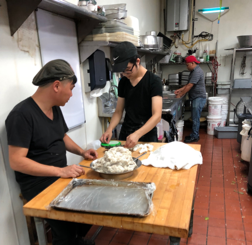
Two chefs at Ginger Bistro making shrimp dumplings
If the flattened dough was not perfect, the dough was rolled back up into a ball and then re-flattened until flawless. The end result was a beautiful tray of appealing dumplings. The artistry and mastering of dim sum was also on display when my family and I visited De Fa Chang in Xi’an, China. De Fa Chang was a most memorable experiences due to the impressive artwork of dim sum on our table. The dumplings were shaped to look exactly like leaves, walnuts, fishes, birds and more, truly demonstrating the importance and emphasis of artful presentation in Chinese cuisine culture. In addition, during a Noodle Narrative class discussion, Dr. Li spoke about the symbolism of food and how food is linked to what a person values. The word for both fish and prosperity is “yu” in Chinese. Perhaps the dim sum artwork reflects this symbolism as well.
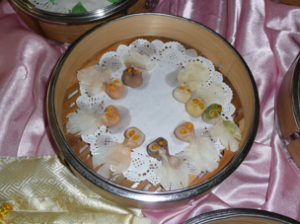
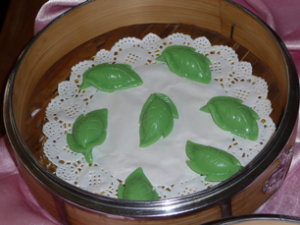
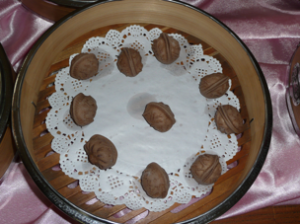
Fish, leaf, walnut dumplings
Proof of the important principles of harmonized flavors and artistry can be found in the artistry of Shu Xi’s poem “Rhapsody of Pasta” where he expressively describes the harmony and artistry in these bite-sized delicacies;
“Lovely and pleasing, mouthwatering,
The wrapper is thin, but it does not burst.
Rich flavors are blended within,”
…
“The aroma swiftly spreads far and wide.
People strolling by drool downwind.”
This beautifully written piece of art demonstrates that the Chinese valued harmonized flavors and artistry centuries ago as they still do today.
The elegance and sophistication required to make these harmonized and artistic masterpieces make dim sum one of the most challenging cuisines to master. It may take decades for a chef to truly master this art as it is very labor intensive and complicated, and requires the upmost attention to detail. The Chinese principle of hard work resounds with the preparation of dim sum. For example, Yu Seafood’s head dim sum chef (Chef Fung) has been making dim sum for more than 32 years. He states in his interview video with Toronto Star “Dim sum is easy to learn, hard to master…you have to put your heart into it.” Dim sum chefs typically start their work in the early hours of the morning to open their restaurants early. Imagine the work ethic involved in having to perfect the hundreds of dishes that make up dim sum.
Of all of the many varieties of dim sum dishes, some of the most popular are rice noodle rolls, shrimp dumplings, shumai (shrimp and pork dumpling), and bao. Out of all of the magnificent dim sum dishes, rice noodle rolls seem to make a very common appearance on dim sum tables. It is impossible to go into detail for each of the many varieties of dim sum dishes. While each dish has its own unique story, exploring one popular dish should provide some understanding as to the deep history, tradition, flavors and preparation involved. Based on the anthropological method of observation, rice noodles are a very common appearance on dim sum tables. Many Chinese families order this dish not only in restaurants in China, but also in San Francisco’s famous dim sum restaurant, Yank Sing, as well as an authentic restaurant in my home town (Ginger Bistro). Rice noodle rolls can be filled with different ingredients such as shrimp, eggs, or pork and they are wrapped in rice noodles. To make the rice noodle rolls, one must first prepare the fillings to go inside the rice noodle. Then, lay the rice noodle sheet out on a pan. Place the filling in a straight row across the rice noodles, making sure to leave space between the each of the rows. Next, cut the rice noodle into separate pieces and roll up the ingredients. Douse the rice noodle rolls in soy sauce and finally eat! Rice noodles are a traditional food in China and originated during the Qin dynasty. Records from history show that when northern China invaded southern China, they were not used to eating rice so they preferred noodles made from wheat flour. Adapting to the more southern ways, the northern cooks started to make their noodles using rice. As time went on the rice noodle evolved and became a very popular dish all across the world especially in Southeast Asia (Traditional Chinese Rice Noodles: History, Classification, and Processing Methods 123).
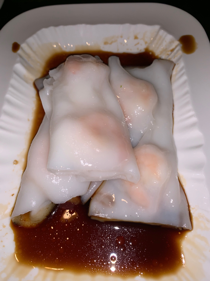
Shrimp Rice noodle roll
Serving of Dim Sum
In addition to the harmonizing and artistry that make dim sum special, the way that it is served makes for a unique experience as well. Many varieties of dim sum are steamed in bamboo baskets that play a dual purpose as a serving vessel. Originally, a variety of these baskets and plates would be carried to the waiting patrons by waitresses using a tray with a strap around their neck to help support the weight. This serving method evolved to what many believe to be the traditional and authentic way of serving dim sum on push carts. Waitresses push these carts filled with a variety of dishes to each table allowing the customers to decide which dishes to choose. The waitress then stamps the card to record what was selected. Observing this in a dim sum restaurant in China, it seemed like an uncontrolled storm of carts swirling around the room. However, there is an order to how dim sum is served. The lighter, steamed dishes come first, then the more exotic dishes, then deep fried dishes, and then finally the dessert or sweeter dishes. This is consistent with a passage from “Chinese Food” by Liu Junru where the author states “Chinese cuisine is particular about matching vegetable and non-vegetable dishes, and there is a proper order for serving cold and hot dishes and savory and sweet” (38). In some ways, this mixing of carts together is a metaphor for the mixing and harmonizing of flavors.
Interestingly, many restaurants have never used or have moved away from the cart method to a menu or checklist style of serving dim sum. This is the method used in the authentic dim sum restaurant in my town, Ginger Bistro. The customer marks what they would like on the checklist menu and the food is brought directly to the table in steamer baskets. My family and I also visited one of the oldest tea houses still in existence, Luk Yu Tea House in Hong Kong, China. This tea house has been serving dim sum for over 86 years, and the restaurant’s quaint booths and smartly dressed waiters made up for the fact that they used the menu system instead of the “traditional” cart system.

My father and I at Luk Yu Tea House
There are a number of possibilities why restaurants may lean more towards using the menu/checklist system. First, carts may require more space to navigate the tables, which would lessen the number of tables and chairs, and therefore customers, leading to less profit. Another possibility could be that the cart system is more expensive and requires more staff to push the carts around. Further, some restaurants may not have the volume of customers to warrant in this cart system as it could lead to much food waste. From the customers’ point of view, preferences differ. Some prefer the traditional cart system for its authenticity and ability to visually choose dishes, while others prefer the menu with the perception that it allows them to have dishes made specifically to their order. Regardless of which method, a constant is the hustling of the waitresses. While at Ginger Bistro, waitresses are always on-the-go, hard at work while serving the customers.
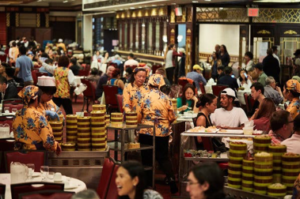
Cart System
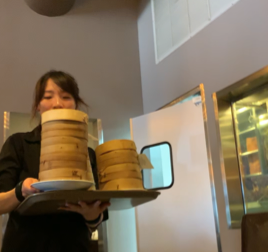

Waitress at Ginger Bistro serving using menu system
Recently, the dim sum experience has also expanded outside of a traditional restaurant setting. The use of food trucks to serve dim sum as well as frozen and packaged dim sum dumplings are becoming increasingly popular. Though these ways may be easier and faster, they are not conducive to the authentic and traditional experience that should be felt while eating dim sum.
Dim Sum Love and Connection
In “Chinese Food” Liu states, “The idea of having families and friends enjoying great food at the table, for the Chinese, is full of warmth and creates a harmonious atmosphere… Dining together is an important way for the Chinese to have increased interpersonal understanding and communication” (37). This quote resonates directly with the communal experience of eating dim sum. While the preparation and artistry of dim sum is important to the Chinese cuisine culture, gathering for dim sum with family and friends demonstrates this importance of connection and love. Dr. Li stated in a Noodle Narrative class discussion that Chinese people normally do not say “I love you”, rather they show their love through favorite meals. An example of this is from the short film “Bao” where the mother cooks her son a table full of Chinese dumplings and bao to show her love for him. It can also be seen at the end of the film when the whole family is bonding over preparing bao together. Throughout my travels from China to San Francisco to New York to even my home town, I have consistently observed multigenerational families sitting around huge round tables with Lazy Susans indulging in massive amounts of dim sum usually served with oolong or jasmine tea. The love, connection and warmth felt around these tables truly exemplifies this crucial part of Chinese culture.
Further evidence of the importance of this type of cuisine to Chinese culture is its role during special occasions such as the Chinese New Year. On Chinese New Year’s Eve, family members bond over making dumplings. At the start of Chinese New Year, they connect with one another while eating the dumplings together. It is stated in “Chinese Food” that the southern part of China’s first meal of the Chinese New Year is usually not dumplings but usually glutinous rice balls, which is another dim sum dish. Regardless of a special occasion or a simple meal with family it is clear enjoying dim sum cuisine demonstrates the connection and love so important in Chinese culture.
In Dim Sum(mary)
From its earliest beginnings centuries ago to its popularity today, dim sum cuisine is steeped in Chinese culture. Dim sum dishes epitomize the harmonious flavors, beautiful artistry, connection and love like no other. It is fascinating to see how much dim sum has evolved over the years, however, the underlying Chinese principles have remained the same. Centuries ago, Shu Xi wrote beautiful poems about dumplings and steamed buns that are still relevant and relatable today. The translation of dim sum as “touch of heart” is apropos. Chef Fung says, one must put their heart into mastering dim sum creations. Equally important is the love that is shared when connecting friends and families over a table full of steaming bamboo baskets.
References/Work Cited
“CANTONESE KITCHEN.” Cantonese Kitchen – Treasure Dim Sum, www.dimsum.nl/dim-sum/history/.
“Dim Sum History, about Carts vs Check Sheets, and Their Future – General Discussion – Dim Sum.” Chowhound, 12 Dec. 2010, www.chowhound.com/post/dim-sum-history-carts-check-sheets-future-719520.
Jaaksola, Sara. “A Brief History of Dim Sum in China.” Culture Trip, The Culture Trip, 25 Jan. 2017, theculturetrip.com/asia/china/articles/a-brief-history-of-dim-sum-in-china/.
Liu, Junru. Chinese Food. Cambridge University Press, 2011.
Noodle Narrative Class Discussion
Parkinson, Rhonda. “Your Complete Guide to Dim Sum, the Traditional Chinese Brunch.” The Spruce Eats, The Spruce Eats, 27 June 2019, www.thespruceeats.com/delicious-dim-sum-chinese-brunch-694544.
Radez, Wes. “What Is Dim Sum?” Dim Sum Central, www.dimsumcentral.com/what-is-dim-sum/.
R. Knechtges, David. (2014). 26. Early Medieval China Shu Xi’s “Rhapsody on Pasta”: A Sourcebook. 10.7312/swar15986-035.
“Silk Road.” History.com, A&E Television Networks, 3 Nov. 2017, www.history.com/topics/ancient-middle-east/silk-road.
Star, Toronto. “The Art of Dim Sum Explained and Demonstrated by Master Chef.” YouTube, YouTube, 12 Nov. 2017, www.youtube.com/watch?v=vAcp-lbFVwo.
Tai, Gloria. “The Art of Dim Sum.” China Live, chinalivesf.com/art-dim-sum/.
“Traditional Chinese Rice Noodles: History, Classification, and Processing Methods.” Traditional Chinese Rice Noodles: History, Classification, and Processing Methods, www.aaccnet.org/publications/plexus/cfw/Documents/CFW-60-3-0515.pdf.
Williams, Claire. “History of Dim Sum.” Yauatcha Life, 19 Jan. 2017, www.yauatcha.com/life/home/home-featured/history-of-dim-sum/.
